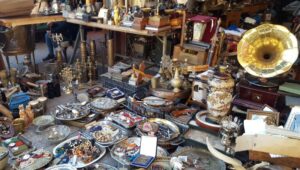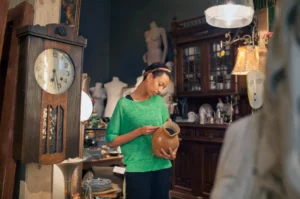Have you ever stood in an antique shop or scrolled through an online store and wondered—what exactly is the difference between antique and vintage? You’re not alone. These two terms are often used interchangeably, but they actually mean different things. Whether you’re a seasoned collector, a curious browser, or someone looking to sell items to top dollar antique dealers in NJ, understanding the difference can help you make smarter buying (and selling) decisions.
Let’s break it down in the simplest way possible.
What Does “Antique” Mean?
The term antique refers to something that is at least 100 years old. That’s the general rule in the world of collectibles, recognized by most experts and antique dealers in NJ and beyond.
So, if it’s 2025, anything made before 1925 is typically considered an antique.
Key Features of Antiques:
-
Usually over 100 years old
-
Handcrafted or made using old methods
-
Often made from wood, porcelain, metal, or glass
-
Includes furniture, clocks, artwork, coins, and more
These items are appreciated for their craftsmanship, historical value, and rarity. If you’ve inherited an old dining table from your grandparents and it dates back to the 1800s, chances are it’s a true antique and worth looking into for appraisal by antique dealers NJ collectors trust.
What Does “Vintage” Mean?
Vintage usually refers to items that are 20 to 99 years old. These aren’t old enough to be antiques, but they’re still considered valuable due to their age, style, and nostalgia.
The term is often used for things like:
- Vintage clothing (1950s dresses, for example)
- Mid-century modern furniture
- Retro kitchenware
- Old records, cameras, and tools
So, if you have a colorful rotary phone from the 1970s or a denim jacket from the 1980s, those items would fall into the vintage category.
Why the Difference Matters
Understanding the difference helps both buyers and sellers. For collectors, the value of an item often depends on how old it is, its condition, and whether it’s antique or vintage. For sellers, especially those trying to get the best price from top dollar antique dealers in NJ, labeling something correctly can mean the difference between a quick sale and an overlooked treasure.
Age Isn’t Everything
Just because something is old doesn’t always mean it’s valuable. Rarity, brand, condition, and demand also play a huge role. Some items may be antique but have little market demand, while others might be vintage yet highly sought after by collectors.
For instance, a vintage Coca-Cola sign from the 1950s might fetch more money than a generic antique wooden chair from the 1890s. Dealers and appraisers from trusted antique shops in NJ often evaluate multiple factors before giving a final value.
Materials and Craftsmanship: A Clue to Age
Want to tell whether your item is antique or vintage? The material and craftsmanship often give it away.
Signs of Antiques:
-
Hand-cut wood joints
-
Wear from natural aging (not machine distressing)
-
Handmade details like carvings or hand-painted elements
-
Patina on metal and wood finishes
Signs of Vintage:
-
Mass-produced pieces with stamps or brand labels
-
Synthetic materials like plastics (popular after 1940s)
-
Mid-century modern design features
You can always consult with antique dealers NJ locals rely on to help authenticate your piece.
Common Examples of Antique vs. Vintage Items
| Item Type | Antique Example | Vintage Example |
|---|---|---|
| Furniture | Victorian-era wooden dresser (1890s) | Mid-century modern chair (1950s) |
| Jewelry | Edwardian diamond ring (early 1900s) | 1980s gold-plated costume jewelry |
| Clothing | 1910s hand-stitched blouse | 1970s bell-bottom jeans |
| Toys | Tin wind-up toy from 1920 | 1980s action figures |
| Cameras | Box camera from 1905 | Polaroid camera from 1970s |
Knowing popular styles can also help you identify an item’s age.
Antique Styles:
-
Victorian (1837–1901): Ornate, dark wood, heavy detailing
-
Georgian (1714–1830): Symmetrical, classic elegance
-
Edwardian (1901–1910): Light colors, intricate designs
Vintage Styles:
-
Art Deco (1920s–30s): Geometric, flashy, bold lines
-
Mid-Century Modern (1940s–60s): Clean lines, wood mixed with plastic or metal
-
Retro (1970s–90s): Bright colors, funky patterns
Why People Love Collecting Antiques and Vintage Items
Whether it’s for the nostalgia, the investment potential, or the uniqueness, there’s a reason so many people love hunting down old treasures. Unlike mass-produced modern goods, these pieces have history and personality. They tell stories of the past, and every scratch, curve, or faded edge adds to their character.
Buyers in New Jersey often search for “Antique Dealers NJ” or “Vintage shops near me” to discover one-of-a-kind finds for home décor, collections, or resale.
Tips for Buying from Antique Dealers in NJ
Thinking of browsing antique markets in New Jersey or selling some old items?
Here’s what you need to keep in mind:
-
Do Your Research
Understand the era, style, and market value before you buy or sell. -
Look for Reputable Dealers
Search for reviews online or use terms like Top Dollar Antique Dealers in NJ to find professionals with good reputations. -
Don’t Be Afraid to Ask Questions
A good dealer will happily share knowledge and background information. -
Check for Authenticity
Ask for documentation or appraisals if available—especially for higher-value items. -
Negotiate When Appropriate
Many prices are open to discussion, especially at flea markets and antique fairs.
Can Something Be Both Antique and Vintage?
Technically, yes—but it depends on who you ask.
Some collectors refer to an item that is just over 100 years old as “vintage antique,” especially if it still feels modern or stylish. However, for clarity, most dealers separate the two based on the 100-year mark.
Still, you might hear phrases like:
-
“Vintage-inspired antique piece”
-
“Early 20th-century vintage item”
-
“Antique with vintage appeal”
In New Jersey, where many antique dealers NJ serve a wide range of tastes, it’s common to see both categories in the same shop.
Where to Find Antique and Vintage Treasures in NJ
New Jersey has no shortage of antique malls, flea markets, estate sales, and dealer shops. Some places specialize in high-end antiques, while others are great for casual treasure hunters.
Look for:
-
Local antique fairs and festivals
-
Downtown antique shops in places like Lambertville, Montclair, and Red Bank
-
Listings that advertise “Top Dollar Antique Dealers in NJ” for sellers
Many antique stores also offer appraisal services if you’re not sure what you have.
Selling Your Antiques or Vintage Items in NJ?
If you’re clearing out your attic or downsizing your collection, the right antique dealer in NJ can help you earn top dollar. Here’s how to get started:
-
Take clear photos of the item
-
Note any damage or repairs
-
Write down what you know about its history
-
Ask for multiple opinions before committing to a sale
Search online using keywords like “sell antiques NJ” or “vintage buyers near me” to find shops or individuals looking to purchase.
Final Words from the Past (With a Modern Twist)
Antique and vintage items aren’t just “old stuff.” They’re time capsules from the past—each one with its own identity, craftsmanship, and charm. Whether you’re looking to collect, decorate, or sell, knowing the difference between the two can help you appreciate the value and meaning behind every item.
If you’re located in New Jersey and want to explore your options, there are plenty of Antique Dealers in NJ & NYC residents trust for expert guidance, fair pricing, and top-quality treasures. Just a short visit to a local dealer could open a door to the past—and maybe even put a little extra money in your pocket.




